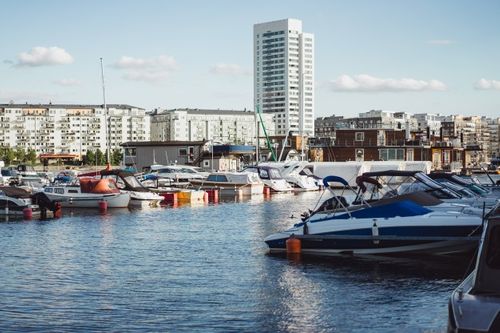Table of Contents
Sweden has one of the most reputed higher education systems in the world. This Nordic country emphasizes group and individual study above lectures. Further, the growth of students is aided by the concepts of freedom and responsibility. Use this blog as a guide to discover all you need to know about the cost of living in Sweden.
Whether you plan on moving immediately, in a month, or in the near future, this blog has all you need to know about relocating to this beautiful Nordic country.
Cost of living
The cost of living in Sweden varies depending on where you live, but it is expensive on average. The majority of this high cost is accounted for by rent rates, which climb at a pace of roughly 1% every year. In recent years, Sweden has had a housing shortage as a consequence of increased demand from individuals migrating to the country for its high quality of life.
The property market in Sweden has become competitive to the extent that both first- and second-hand rentals are now available. A first-hand rental is someone who rents from the original owner of a property. Second-hand rentals are known as “sublets” in other countries, and they refer to renting from a current renter (i.e., the holder of the first-hand lease).
In most cases, foreign travelers and international students may only secure second-hand leases for the first few months or half-year in Sweden. These leases have the drawback of seldom lasting more than a year or two. Therefore, new arrivals to Sweden may find themselves packing up and moving around frequently.
Average living costs in Sweden by city

Stockholm, the capital of Sweden is also its most costly city. Gothenburg and Uppsala are the next cities on the list. Cities like Nykvarn and Södertälje are substantially less expensive.
Stockholm’s Average Monthly Costs (Excluding Rent)
| A Family of four | 34,000 SEK or 3,900 USD |
| Single person | 12,000 SEK or 1,400 USD |
Average Monthly Costs in Uppsala (Excluding Rent)
| A Family of four | 33,000 SEK or 3,800 USD |
| Single person | 9,000 SEK or 1,050 USD |
Average Monthly Costs in Gothenburg (Excluding Rent)
| A Family of four | 31,500 SEK or 3,800 USD |
| Single person | 9,000 SEK or 1,050 USD |
University tuition expenses in Sweden
Tuition for EU/EEA students.
European Union and European Economic Area (EU/EEA) students pay a cheaper tuition cost. Students from the EU/EEA, other Nordic countries, and Switzerland do not have to pay tuition at Swedish public universities for Bachelor’s and Master’s degrees. However, free Ph.D. courses are available to all foreign students, regardless of their country of birth.
Tuition for non-EU/EEA students
Tuition fees are charged to students from non-EU/EEA countries. Depending on the degree program and university, the prices range from 7,500 to 25,500 EUR each year. Some of the most premium degrees include business and architecture. Non-EU/EEA citizens must also pay a university application fee, which is typically approximately 90 EUR but varies by institution.
Top Universities in Sweden
- Karolinska Institute
- Lund University
- Uppsala University
- Stockholm University
- University of Gothenburg
- KTH Royal Institute of Technology
- Chalmers University of Technology
- Linköping University
- Swedish University of Agricultural Sciences
- Umea University
- Jönköping University
- University West
- University of Boras
- Linnaeus University
- World Maritime University
The average cost of living for students in Sweden
In Sweden, the cost of living for students is higher than the European average. Amounts ranging from 700 to 1,200 EUR are paid each month. Take a look at the average cost of living in the best places to live in Sweden.
| City | Average cost |
| Gothenburg | 1,250 EUR/month |
| Stockholm Lund | 1,250 EUR – 850 EUR per month |
| Linkoping | 850 EUR/month |
| Uppsala | 750 EUR – 1,200 EUR per month |
Accommodation costs
Your best option is to start looking for housing at your university or college. It frequently gives important information or connects you with the organizations in charge of student living halls (or dormitories). Dormitories are beneficial since they allow you to interact with both local and foreign students. Making friends and finding others with similar interests is easy. Prices for university accommodation range from 240 to 620 EUR per month.
Renting or sharing an apartment is the second option. You can expect to pay between 350 and 700 EUR every month. You may select where you live, and you can share a huge apartment with several other students. It is, however, more expensive than a student room. Nonetheless, this is a fantastic way to save money while avoiding loneliness, especially if it’s your first time living abroad.
Food costs

What about the cost of food in Sweden? Expect to spend roughly 200 EUR per month on meals. This is dependent on your eating habits, whether you cook, and other factors. If you buy food from low-cost supermarkets like ‘Lidl’ or ‘Willy’s’, or from outlets on the outskirts of the city, you can save money.
A meal in a Swedish restaurant will set you back between 8 and 10 EUR. In a typical restaurant, a three-course meal for two costs between 45 and 65 euros. A simple drink with your coworkers in a bar will set you back 6 EUR.
Average prices for food, alcohol, and gas in Sweden
| Item | SEK | USD |
| One dozen eggs | 28 | 3 |
| One bottle of wine | 100 | 11 |
| Half a litre of beer | 17 | 2 |
| Meal at an inexpensive restaurant | 120 | 14 |
| One litre of gas | 16 | 2 |
In Sweden, the legal drinking age is 18, yet Systembolaget (a government-owned chain of liquor stores) will only sell to people over the age of 20.
Utility costs
Utility expenses in Sweden are quite low as compared to Swedish rental prices. Most rentals come with Wi-Fi included in the fee since first-hand rental contracts are hard to come by, making it difficult for tenants to sign up for internet without a lease. Water and electricity are frequently supplied as well. Basic utilities might cost around 1,300 SEK on average (150 USD).
Cost of transportation
Students in Sweden value public transportation. More than 40% of them use it to get to and from university and other city destinations. Students should expect to pay between 40 and 55 EUR per month for public transportation.
You may also choose to travel by bicycle, which would cost you roughly 110 EUR. In Sweden, around 27% of students ride bicycles to get around the city.
Additional living expenses in Sweden.
- 80 EUR per month for books and other study material.
- 70-100 EUR per month for social and recreational activities.
- Rates for health insurance begin at 30 EUR per month.
Key Takeaways
- The most important takeaway here is that Stockholm is by far Sweden’s most costly city. However, there isn’t much difference, and picking one of the smaller cities over Gothenburg or Malmo saves you only a small amount of money.
- When compared to other costs in the country, public transportation in Sweden is swift, efficient, and fairly priced.
- When it comes to healthcare, Sweden distinguishes itself from the rest of the globe. The healthcare system in this nation is functional and efficient.
Liked this blog? Read next: A comprehensive guide to procuring a Swedish student visa
FAQs
Q1. For an international student, what is the cost of living in Sweden?
Answer – To pay for all of their living expenses, students in Sweden should need at least 8,568 SEK each month.
Q2. How long can an international student stay in Sweden after graduation?
Answer – After completing your studies, you can stay in Sweden for six months to look for a job.
Q3. In Sweden, what is the average rent for accommodation?
Answer – The average rent in Sweden is 9,500 SEK.







